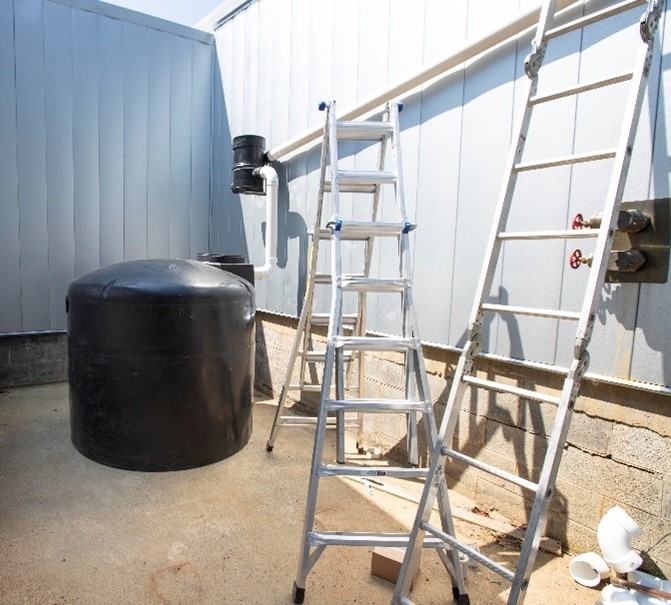Cisterns: Using Old Technology in New, Sustainable Ways


Facilities Management at the University of Virginia is taking steps to change the way people think about water conservation. Dawson Garrod is a civil engineer and UVA alumnus (Engr ’02), and Jess Wenger is an environmental projects manager and double Hoo in environmental sciences (Col ’04 and Grad Arts & Sciences ’08). Garrod and Wenger work in Environmental Resources in Facilities Management’s department of Operations.
CISTERNS: USING OLD TECHNOLOGY IN NEW, SUSTAINABLE WAYS
At UVA, we are using a very old idea, cisterns, to capture rainwater and use it in beneficial and creative new ways.
Facilities Management Fleet
Prior to improvements to the Facilities Management yard in 2019, there was not a location on site for fleet vehicle washing. Facilities Management staff wanted to increase the sustainability of its operation by installing a vehicle wash bay in the newly redesigned Facilities Management yard. The wash bay contains a drain that allows soapy wash water to be sent to the sanitary sewer for treatment at the sewage treatment plant and allows staff to quickly and efficiently wash vehicles on site.
In alignment with the University’s sustainability goals, Facilities Management staff wanted to go the extra mile by installing a cistern to capture rainwater for use in the fleet vehicle washing operations. With grant funding procured by UVA Clean Water, a student group division of the Environmental Stewardship Subcommittee, and help from Facilities Management’s Transportation Operations and Fleet Manager Mike Duffy, a 700-gallon cistern was recently installed in the Facilities Management yard and is scheduled to be fully operational this upcoming summer. Although most visitors to Grounds will never know it exists, the newest addition to UVA’s stormwater management efforts is projected to contribute a significant cost saving to the University when it is combined with the Facilities Management wash bay facility.

In addition to saving money and reducing potable water consumption, utilizing the cistern will have many other benefits. The naturally soft water from the cistern will reduce the amount of detergent needed to wash vehicles. This not only reduces the amount of soap needed during the washing operation, but it also reduces the amount of water treatment needed at the wastewater treatment plant once it goes down the sanitary sewer drain. As added benefits, soft water does not degrade the vehicle’s clear coat and finish on the windshield and does not break down wax as quickly. This one little cistern is going a long way to reduce vehicle maintenance costs!
As any backyard gardener with a rain barrel knows, cisterns aren’t just for washing cars. Facilities Management landscapers can also benefit from the cistern. Currently, landscape areas and planters are watered using potable water stored in tanks that are installed in the bed of Kubotas which travel around Grounds. Filling up their tanks at the cistern will allow the landscapers to water the plants with actual rainwater and help ensure Facilities Management and the University are being good stewards of the environment and our resources.

Stormwater Management and the Environment
Rainwater harvesting not only cuts down on the use of potable water but also reduces the amount of stormwater runoff that reaches our local streams and rivers. Reducing the quantity of rainfall running off paved surfaces, such as buildings, sidewalks, and parking lots ultimately reduces erosion and pollution in our local waterways. UVA is located in the Chesapeake Bay watershed and also holds a stormwater permit with the Virginia Department of Environmental Quality. Incorporation of stormwater management practices, like cisterns, can help reduce pollutant loads to local streams, and these positive impacts can reach all the way to the Bay!
The installation of this cistern is yet another sustainable step in improving the University by changing the culture, or the way people think about water conservation and what is possible with water use.
- Stay on Track: Turning Resolutions into Results
- From “Jimmy Who?” to “What Would Jimmy Do?”
- Washington’s Bold Gamble: Christmas Day 1776
- Increasing Your Impact With Planned Giving
- UVA Club of Boston: UVA Men's Basketball Game Watches
- UVA Club of New Mexico: Cavs Care - Roadrunner Food Bank